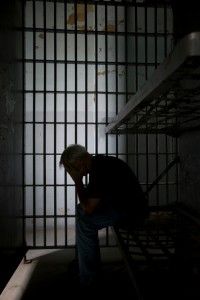 Anthony Graves spent 18 years on death row in Texas, all in solitary confinement. He was the fifth and last witness to speak at a Senate Judiciary Committee hearing on solitary confinement Tuesday morning.
Anthony Graves spent 18 years on death row in Texas, all in solitary confinement. He was the fifth and last witness to speak at a Senate Judiciary Committee hearing on solitary confinement Tuesday morning.
Mr. Graves spoke eloquently and powerfully to a packed room and an overflow audience about his experience, the deplorable conditions, and the lasting psychological effects he cannot escape. He was exonerated and released from prison around two years ago, but still carries the scars. He spoke of watching completely sane individuals come to death row, and within three years lose their grip on reality. He described what it was like to live in a very, very small box 23 hours a day, forced to sit like a trained dog when guards delivered food.
One argument against the death penalty is the danger of executing the innocent. It’s a strong argument – Mr. Grave’s case highlights this – but no one should have to live in the conditions he described.
Solitary confinement makes our criminal justice system the criminal.
The one witness in disagreement was the first witness to testify – Charles Samuels, the director of the Federal Bureau of Prisons. In his statement he stressed the need for solitary to ensure security in prisons, and to protect the safety for those who work there. But at the forefront of the minds of Senators Dick Durbin (D-IL) – chair of the subcommittee on the Constitution, Civil Rights and Human Rights who presided over the hearing – Lindsey Graham (R-SC) and Al Franken (D-MN) was how solitary confinement affects the mental health or prisoners.
Mr. Samuels argued that only around 3% of prisoners suffer from mental health issues. However, Bureau of Justice statistics suggest that as many as 16% of adult inmates suffer from some type of mental illness, and that the number continues to grow.
According to the National Alliance on Mental Illness (NAMI), placing mentally ill inmates in solitary confinement is one of the worst possible things that could be done. Mr. Samuels assured the Senators that mental health evaluations are conducted, that extensive procedures are in place to ensure that the wrong people don’t end up in solitary, and that the cases are constantly reviewed.
But Pat Nolan, a former member of the California State Assembly and the current President of Justice Fellowship, painted a different picture. Having visited super max prisons, he said there is little to no oversight or review process relating to solitary, and often the ones who get put there are not the most dangerous or the “worst of the worst”.
Professor Craig Haney, a researcher and expert on prison life (who was involved in the Stanford Prison Experiment), and Stuart M. Andrews Jr., a South Carolina lawyer engaged in litigation over a lack of mental health care for inmates, were more in agreement with Mr. Nolan. They disputed Mr. Samuels vision of a prison system in which inmates are not subject to deplorable conditions, are treated fairly, offered programming and treatment, and their mental health is closely monitored.
The United States has the world’s largest prison population, and has increased its use of solitary confinement since the late 1970s. As this hearing reveled, this has had serious “human rights, fiscal and public safety consequences.” Even if prison is sometimes necessary, surely we can keep society safe without degrading the mental health of our prisoners, and without killing them.
